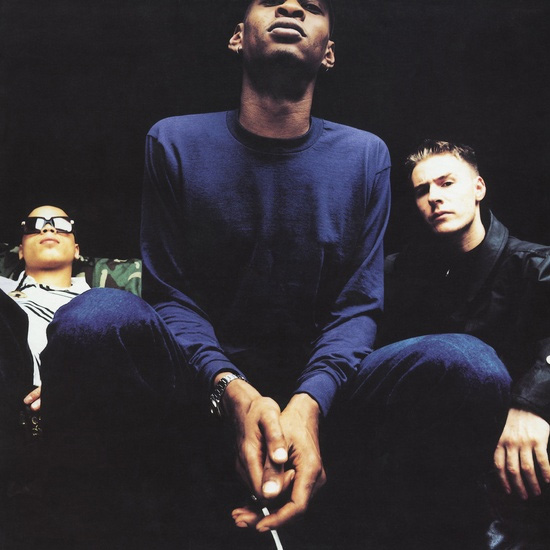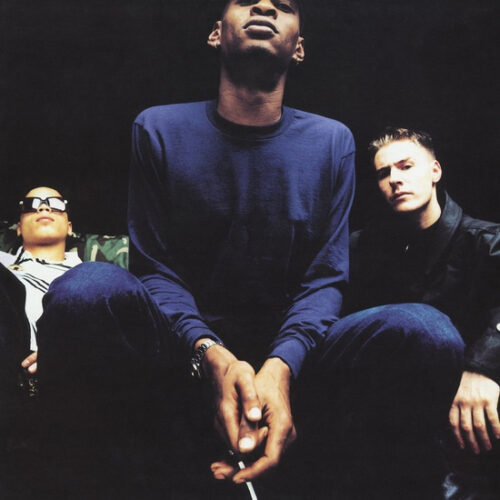Brooding, dark, eclectic and beautiful, Massive Attack’s Blue Lines is the landmark release from 1991. A stunningly original work, it was an album that joined the loose ends of music scenes as diverse as soul, punk and post punk, hip hop, dance and even classical.
The record answered the questions set by punk itself, as it soundtracked the comedown from acid house perfectly with ambitious songs that were slowed down to a late night groove, creating a ‘dance music for the head instead of for the feet’ as band member Daddy G once pointed out.
The songs were at once personal, symphonic and soulful, and captured a new multicultural UK, perfectly referencing Subbuteo and Studio One in the same song, as well as the rainy day reality of inner-city, urban life in expansive and imaginative songs. The Bristol-based group made an eclectic masterpiece that managed to capture all the loose ends of British pop culture into a seamless and perfect whole that was also a huge hit.
Could there be a more perfect record that sums up the cross pollination of ideas of the early nineties?
This truly was a roots album from a roots band. With its heart in the smoky clubs of Bristol and the cross section of sounds from dub reggae to punk to post punk to hip hop and soul, Blue Lines captured the new soundscapes of eighties into nineties UK, where a myriad of musics were mashed up and messed up by Es and all-nighters, and saw a tearing up of the template of how to make music.
Massive Attack’s eighties had been a blur of those sound systems and DJ culture. It was a time of adventure in the underground that was the opposite of the dragging mainstream. Year Zero Punk had closed many doors, but conversely the key players like The Clash or Public Image had opened up many more, using the space of dub and the true freedom of punk that could mash krautrock with soul, the sense of musical adventure of Bitches Brew Miles Davis, and the emergent electro cultures coming from New York.
Anyone with ears was checking the reappraisal of classic vinyl from youthful pasts, crackling old soul records, seventies funk, battered reggae releases and post punk adventures. Massive Attack were the true children of this revolution, and could only come from a city where the black and white youth had been immersed in each other’s musical cultures.
Massive Attack were a collective built around a creative core of former graffiti artist and punk kid Robert "3D" Del Naja, Grant "Daddy G" Marshall and Andrew ‘Mushroom’ Vowles.
There was no focal point – just the songs. The best voice got the mic, the best beats were the backing track. They were never a traditional band. They were a collective with guest singers – a new idea in creating music and a template that the Gorillaz, amongst others, would borrow a couple of decades later.
They came together as an offshoot of the Wild Bunch – an ad hoc collection of misfits who were at the heart of Bristol underground party scene of the eighties.
Despite having a smaller post punk soundscape than other UK cities, Bristol already had a tradition of multi-styled musical movements. The Pop Group had sparked it in the punk era with their fierce combination of punk rock and the sharp end of James Brown funk and adventures into skewed dub – their open minded explorations tore the fabric, and the best Bristol musicians followed into this space. Combined with the port city’s multi-racial flavours and musics, you had a ripe space for creativity and combinations.
The Wild Bunch were the main sound system in this Bristol, mixing it up musically at huge parties. A fluctuating crew of music freaks were added to the musical core of Massive Attack, including Tricky and Nellee Hooper, who moved to London after the group’s dissolution and worked as a producer and remixer for a number of major artists, including Madonna, U2, No Doubt, Björk and others and was also a member of Soul II Soul. This was a wildly creative crew of people.
The Wild Bunch first appeared on the national radar in 1985 with a cover of Burt Bacharach’s ‘The Look of Love’, featuring future massive Attack guest singer Shara Nelson on vocals. Then in 1988 Massive Attack released ‘Any Love’. Their potential was spotted by close friend and initial benefactor Neneh Cherry, who helped them to get signed to Circa Records in 1990.
Tempering their sound system aesthetic, they focused on creating their own songs from samples, and working as a collective they put together Blue Lines, the album that defined 1991. It was the perfect comedown after the frenzy of acid house had busted things wide open and caught the pulsebeat of the times perfectly.
A brooding and powerful record Blue Lines captured that melancholy that hovers just below the surface in all great British music, that rainy day darkness that, when it is combined with the euphoria of great pop culture, is the eternal battle for the soul of our best music.
The songs were polished gems that sneaked into mainstream playlists and propelled the band to the top of the charts, whilst never losing their innate underground soul and sense of space learned from dub culture and other maverick musics.
At the time I interviewed the band, and remember 3D talking of his days as a Bristol punk rocker with a deep love for the Dead Kennedys and crazed cider scrumpy nights, as well as the space, dub soundscapes and sense of entering a whole world in an album of Public Image Limited’s Metal Box.
He also talked of the impact of hip-hop and hip-hop culture – the freedom of creativity and the graffiti art. It was these adventures into sound and art that defined the band, and have still remained with them until their recent Heligoland album, an astonishing work that sees them still never settling on their laurels and seeking out new sounds.
The songs were defined by the guest vocalists, from Horace Andy’s sweet, heaven-sent voice, stained with reggae, to Shara Nelson’s cinematic soul swoop, to the whispery guest vocalists, interspersed with Del Naja and Marshall’s and, initially, Tricky’s similarly hushed vocals, all intoned over carefully constructed tracks.
Co-produced by Jonny Dollar and Cameron McVey, who would become their first manager, the tape op on the sessions was Geoff Barrow, who went on to form Portishead – they were carving out the space for what became known as trip-hop while everyone else caught up.
Post-Blue Lines music has never been the same, as a whole range of artists took the opportunity to enjoy the diverse influences and the sonic adventures offered up by this daring journey. Arguably the first album of the 21st century that arrived a decade early, Blue Lines remains a masterpiece – a serious record for serious times and a signpost to a future.
This essay was written by John Robb for the 20th anniversary reissue of the remixed/remastered Blue Lines which comes out on November 19 via EMI



